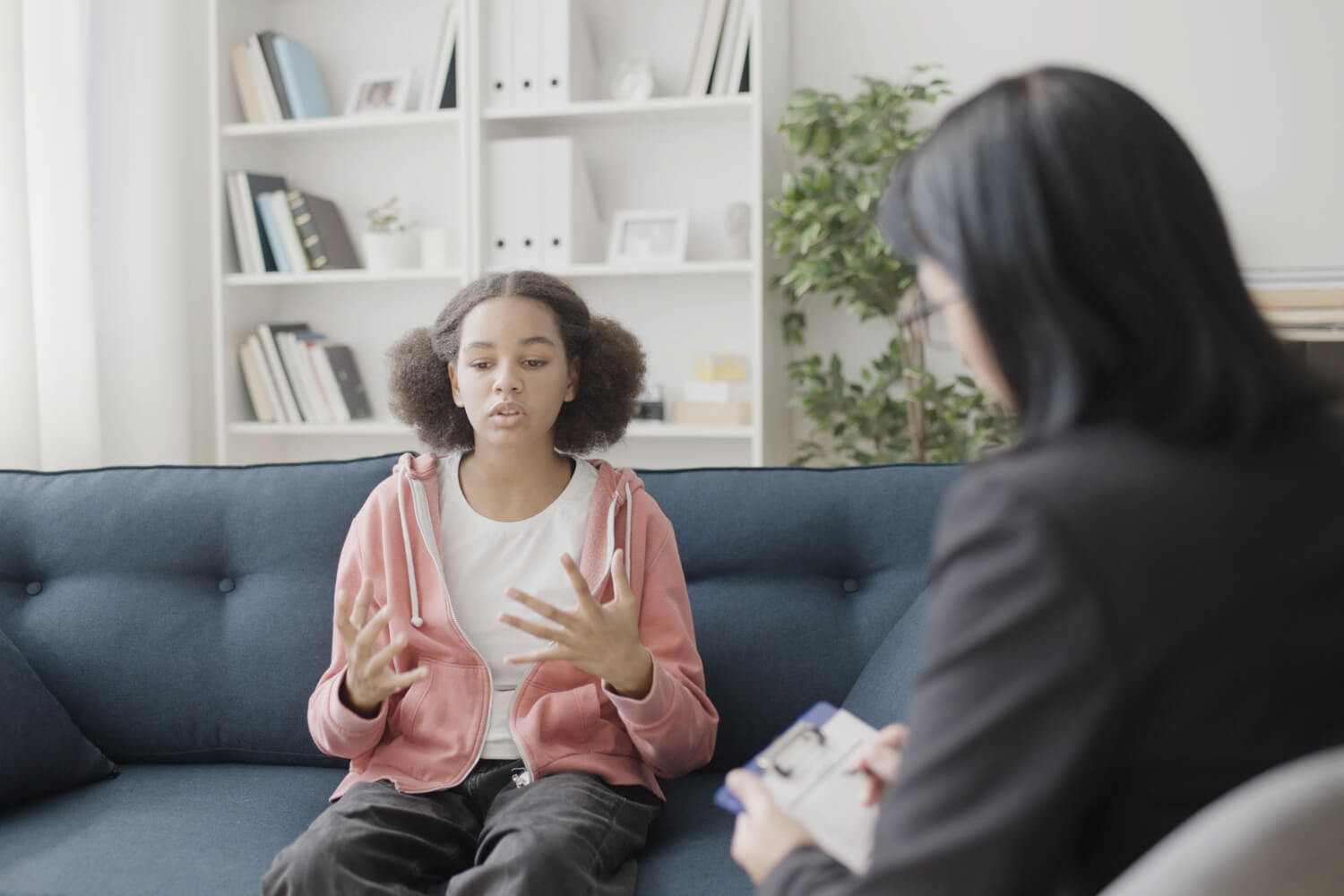Checking Out the Different Kinds Of Treatment Readily Available for Teenagers With a Specialist for Teens
Young adults encounter distinct difficulties that can influence their mental health and wellness. Different therapeutic approaches are customized to resolve these issues properly. From Cognitive-Behavioral Therapy (CBT) to Art Treatment, each method provides distinctive advantages. Recognizing these therapies can help caregivers make educated decisions. What factors should be taken into consideration when choosing the appropriate technique for a teenager? The expedition of these different treatments reveals understandings that can substantially boost teenage health.
Recognizing Cognitive-Behavioral Treatment (CBT) for Teenagers
Cognitive-Behavioral Treatment (CBT) acts as a powerful device for addressing the unique psychological wellness difficulties dealt with by teens. This evidence-based approach focuses on the interaction in between behaviors, sensations, and thoughts, aiding teens determine and alter adverse thought patterns that add to their struggles. Through organized sessions, therapists lead teens in acknowledging their cognitive distortions, fostering healthier coping devices and psychological guideline.
CBT is especially efficient in taking care of anxiousness, clinical depression, and behavior problems, as it outfits teens with practical skills to browse their day-to-days live. The therapy urges self-reflection and advertises a proactive way of thinking, empowering teens to take control of their psychological wellness trip. By setting certain objectives and making use of various techniques, such as journaling and role-playing, CBT cultivates strength and self-awareness. Generally, this therapeutic strategy offers teens with vital devices to face their difficulties and build a more positive expectation on life.
The Benefits of Dialectical Behavior Modification (DBT)
While numerous restorative strategies offer useful understandings for adolescents, Dialectical Habits Treatment (DBT) sticks out for its efficiency in addressing emotional law and interpersonal difficulties. Created by Dr. Marsha Linehan, DBT incorporates cognitive-behavioral techniques with mindfulness methods, making it especially appropriate for teenagers grappling with extreme feelings. This treatment aids teens recognize and understand their feelings, advertising healthier reactions to stressors.
Among the significant advantages of DBT is its concentrate on structure skills in 4 essential locations: mindfulness, interpersonal effectiveness, distress tolerance, and emotional regulation. These skills empower teenagers to deal and browse intricate relationships with tight spots extra properly. In addition, DBT encourages a solid restorative partnership in between the therapist and the teen, cultivating count on and visibility. Therefore, several teenagers experience boosted psychological security and improved coping devices, ultimately leading to a much more satisfying life and more powerful connections with peers and household.
Exploring Art Treatment as an Imaginative Outlet
Art treatment offers young adults a distinct avenue for self-expression and emotional expedition (Therapists For Teens). Via numerous strategies and approaches, it enables them to interact feelings that may be tough to verbalize vocally. By engaging in innovative activities, adolescents can experience restorative advantages that advertise mental health
Benefits of Art Therapy
Engaging in art therapy provides teens with a distinct creative electrical outlet that promotes emotional expression and individual understanding. This restorative approach allows adolescents to connect sensations and experiences that may be tough to express vocally. Through different kinds of imaginative expression, such as drawing, paint, or sculpting, teenagers can discover and refine complicated feelings, bring about enhanced self-awareness. Furthermore, art treatment promotes relaxation and anxiety relief, providing a secure room for people to launch suppressed feelings. The non-judgmental atmosphere motivates experimentation, helping teenagers build self-confidence in their imagination and analytical abilities. Therefore, art treatment can improve general mental health, supplying a useful tool for handling life's difficulties during this vital developmental phase.
Methods and methods
When exploring art therapy as an innovative electrical outlet, numerous techniques and methods can be employed to help with emotional expedition and expression. These may include drawing, painting, collage-making, and sculpting, allowing teenagers to connect feelings that could be hard to articulate vocally. Assisted imagery can also be used, urging people to imagine and develop depictions of their emotions. Additionally, the incorporation of music or movement can improve the creative process, cultivating a deeper connection to their internal experiences. Team art tasks supply possibilities for social interaction and shared recovery. Importantly, the focus in art treatment lies out artistic skill however on the process of production, encouraging teens to find their very own distinct forms of self-expression and insight.
Art as Expression
Imagination acts as a powerful conduit for self-expression, especially for teenagers steering complicated feelings. Art therapy offers an unique electrical outlet for teenagers to check out and connect sensations that might be hard to express verbally. With drawing, paint, or sculpting, teenagers can imagine their internal battles, fostering a sense of understanding and release. This therapeutic method enables individual analysis and urges expedition without judgment. Additionally, taking part in innovative tasks can increase self-confidence and promote emotional strength. As teenagers develop, they may find new perspectives on their difficulties, leading to healing and individual development. Inevitably, art treatment works as an important resource, encouraging teens to browse their emotional landscapes through innovative expression.
The Role of Family Treatment in Adolescent Mental Health

Benefits of Family Participation

Interaction and Conflict Resolution
Effective communication and problem resolution are necessary parts of teenage mental wellness, specifically within the context of family therapy. Family therapy gives a structured setting where teenagers can reveal their thoughts and feelings, fostering open discussion. This healing setup urges household members to actively listen to every various other, promoting understanding and compassion. By addressing conflicts in a risk-free room, teenagers learn useful abilities for handling differences constructively, which can reduce emotional distress. Additionally, these skills enhance family members characteristics, bring about much healthier connections. As teens navigate the complexities of their feelings, family members therapy furnishes them with devices to communicate properly, resolve problems agreeably, and enhance domestic bonds, inevitably supporting their general psychological wellness.
Using Mindfulness-Based Treatment for Tension Decrease
As teens navigate the intricacies of teenage life, incorporating mindfulness-based treatment can work as a powerful tool for tension reduction. This healing technique emphasizes present-moment recognition, assisting teenagers challenge their ideas and sensations without judgment. By practicing mindfulness methods such as deep breathing, body scans, and directed images, adolescents can learn to manage stress and anxiety and stress and anxiety better.
Research study shows that mindfulness-based treatment can enhance psychological policy and strength in teenagers, permitting them to cope far better with social challenges and academic stress (Youth Counselling Near Me). Regular method can bring about boosted emphasis, reduced impulsivity, and higher general wellness. In addition, mindfulness promotes a feeling of link to oneself, promoting self-compassion and reducing negative self-talk
Integrating mindfulness right into treatment sessions offers teenagers useful approaches they can make use of in everyday life, equipping them to browse stress factors with greater ease and self-confidence. Consequently, mindfulness-based treatment comes to be a vital you can try this out source in supporting adolescent mental wellness.
Integrating Play Therapy for Younger Teens and Preteens

Specialists trained in this approach develop a risk-free setting where more youthful teenagers can discover their concerns and establish dealing strategies. By taking part in play, these individuals can much better recognize their feelings and learn to navigate social communications. Furthermore, play treatment can foster strength and analytical abilities, necessary for navigating the obstacles of teenage years. Overall, incorporating play therapy can boost the restorative procedure, supplying more youthful teenagers and preteens with the devices they require to prosper psychologically and socially.
Regularly Asked Questions

Just how Do I Know if My Teen Requirements Therapy?
Indications that a teen may require treatment consist of relentless sadness, modifications in behavior, withdrawal from activities or buddies, scholastic decrease, raised anxiety, compound usage, or trouble managing life changes. Observing these indications can motivate professional analysis.
What Credentials Should I Search for in a Teen Specialist?
When seeking a teen specialist, one should prioritize credentials such as pertinent levels in psychology or therapy, state licensure, specialized training in teen concerns, and experience functioning with teens in numerous healing settings.
How Can I Support My Teen During Treatment?
To support a teen during therapy, one need to actively pay attention, use encouragement, respect their privacy, and validate their feelings. Additionally, fostering open interaction can help them feel much more comfortable reviewing their experiences and emotions.
What Are Common Indications of Mental Health And Wellness Issues in Teens?
Usual indications of psychological health issues in teenagers include persistent despair, withdrawal from friends and tasks, adjustments in sleep or appetite, trouble focusing, increased irritability, chemical abuse, and noticeable decreases in scholastic efficiency or self-esteem. (Youth Counselling Near Me)
For How Long Does Treatment Generally Last for Teenagers?
Treatment duration for teens commonly varies, commonly lasting from a couple of weeks to a number of months. Variables influencing this timeline consist of the person's specific demands, the kind of therapy, Homepage and development made throughout sessions.
From Cognitive-Behavioral Therapy (CBT) to Art Treatment, each method offers distinctive advantages. Cognitive-Behavioral Therapy (CBT) serves as a powerful tool for addressing the one-of-a-kind mental health obstacles dealt with by teenagers. Involving in art treatment offers teenagers with an unique innovative outlet that cultivates emotional expression and personal understanding. Family members treatment supplies a structured setting where teenagers can express their sensations and thoughts, cultivating open discussion. Study suggests that mindfulness-based therapy can boost emotional policy and durability in teens, permitting them to deal better with social obstacles and academic stress.